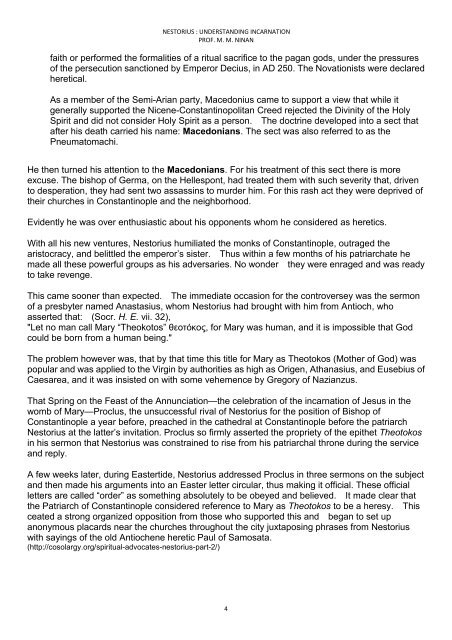Nestorius
You also want an ePaper? Increase the reach of your titles
YUMPU automatically turns print PDFs into web optimized ePapers that Google loves.
NESTORIUS : UNDERSTANDING INCARNATION<br />
PROF. M. M. NINAN<br />
faith or performed the formalities of a ritual sacrifice to the pagan gods, under the pressures<br />
of the persecution sanctioned by Emperor Decius, in AD 250. The Novationists were declared<br />
heretical.<br />
As a member of the Semi-Arian party, Macedonius came to support a view that while it<br />
generally supported the Nicene-Constantinopolitan Creed rejected the Divinity of the Holy<br />
Spirit and did not consider Holy Spirit as a person. The doctrine developed into a sect that<br />
after his death carried his name: Macedonians. The sect was also referred to as the<br />
Pneumatomachi.<br />
He then turned his attention to the Macedonians. For his treatment of this sect there is more<br />
excuse. The bishop of Germa, on the Hellespont, had treated them with such severity that, driven<br />
to desperation, they had sent two assassins to murder him. For this rash act they were deprived of<br />
their churches in Constantinople and the neighborhood.<br />
Evidently he was over enthusiastic about his opponents whom he considered as heretics.<br />
With all his new ventures, <strong>Nestorius</strong> humiliated the monks of Constantinople, outraged the<br />
aristocracy, and belittled the emperor’s sister. Thus within a few months of his patriarchate he<br />
made all these powerful groups as his adversaries. No wonder they were enraged and was ready<br />
to take revenge.<br />
This came sooner than expected. The immediate occasion for the controversey was the sermon<br />
of a presbyter named Anastasius, whom <strong>Nestorius</strong> had brought with him from Antioch, who<br />
asserted that: (Socr. H. E. vii. 32),<br />
"Let no man call Mary “Theokotos” θεοτόκος, for Mary was human, and it is impossible that God<br />
could be born from a human being."<br />
The problem however was, that by that time this title for Mary as Theotokos (Mother of God) was<br />
popular and was applied to the Virgin by authorities as high as Origen, Athanasius, and Eusebius of<br />
Caesarea, and it was insisted on with some vehemence by Gregory of Nazianzus.<br />
That Spring on the Feast of the Annunciation—the celebration of the incarnation of Jesus in the<br />
womb of Mary—Proclus, the unsuccessful rival of <strong>Nestorius</strong> for the position of Bishop of<br />
Constantinople a year before, preached in the cathedral at Constantinople before the patriarch<br />
<strong>Nestorius</strong> at the latter’s invitation. Proclus so firmly asserted the propriety of the epithet Theotokos<br />
in his sermon that <strong>Nestorius</strong> was constrained to rise from his patriarchal throne during the service<br />
and reply.<br />
A few weeks later, during Eastertide, <strong>Nestorius</strong> addressed Proclus in three sermons on the subject<br />
and then made his arguments into an Easter letter circular, thus making it official. These official<br />
letters are called “order” as something absolutely to be obeyed and believed. It made clear that<br />
the Patriarch of Constantinople considered reference to Mary as Theotokos to be a heresy. This<br />
ceated a strong organized opposition from those who supported this and began to set up<br />
anonymous placards near the churches throughout the city juxtaposing phrases from <strong>Nestorius</strong><br />
with sayings of the old Antiochene heretic Paul of Samosata.<br />
(http://cosolargy.org/spiritual-advocates-nestorius-part-2/)<br />
4

















